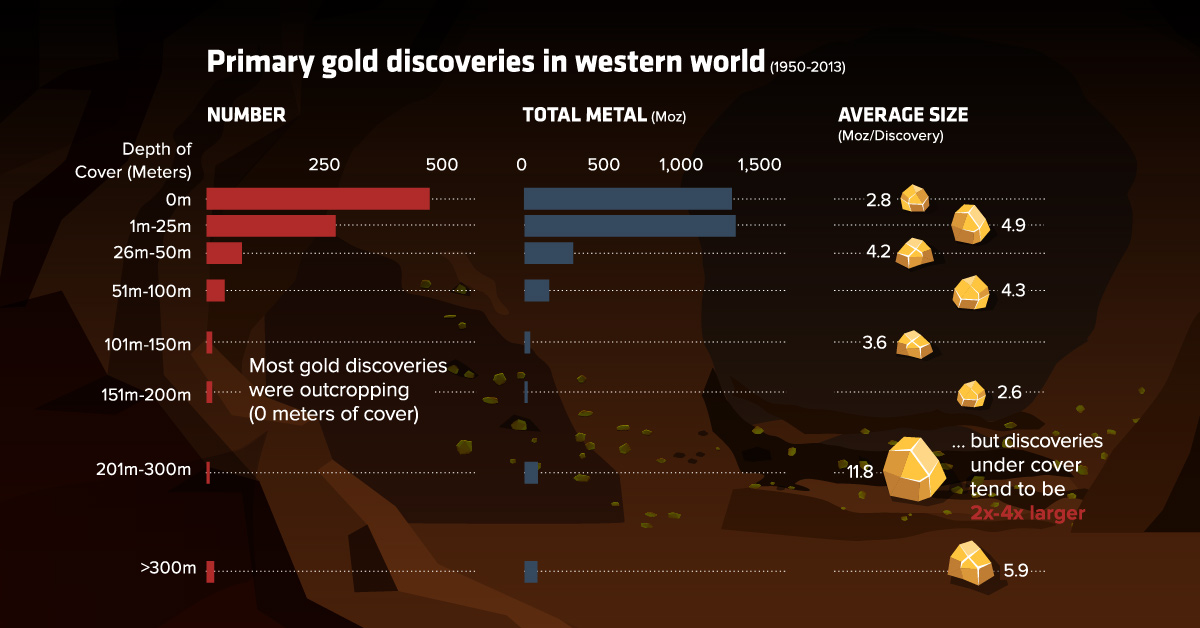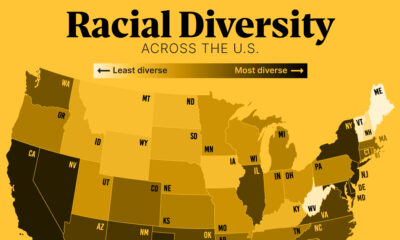Mining
The Future of Gold Exploration is Under Cover

The Future of Gold Exploration is Under Cover
Over billions of years, extraordinary amounts of gold and other metals were deposited and spread throughout the Earth’s crust. Humans have been searching for these rich deposits for centuries, and advances in geoscience and technology have helped us become more adept at finding them over time.
However, even with today’s advancements – almost all early-stage prospecting methods are still based on the same key principle: trying to find areas of exposed bedrock, called outcrops, that indicate an orebody is near.
But such outcrops only form in certain circumstances – and what happens when a geological system doesn’t come in contact directly with the surface?
The Problem of Cover
Today’s infographic comes to us from Nevada Exploration, and it identifies the problem behind finding these “hidden” deposits that do not leave a helpful trail of clues on the surface.
Instead of having outcrops where rocks can be readily sampled, these deposits are trapped underneath large amounts of soil and gravel. Geologists call this a covered setting, where they must first find a way to “see through” the cover in order to identify what geological systems really exist below.
Seeing through cover can be expensive and difficult to do, but it also has big potential upside.
There is no reason not to assume as much gold still exists as has been mined in the past, but prospectors, explorationists, and geologists have found the easy gold.
– Dr. Richard Goldfarb, Ph.D., United States Geologic Survey
In fact, many geologists think that the next game-changing gold deposit could be found under cover.
Exploration 2.0
For explorers, it is no secret that the cost per discovery is going up dramatically over time. The reality is that traditional exploration methods are achieving diminishing returns, and as a result companies are settling for lower grade deposits, more complex geological settings, and politically questionable jurisdictions.
Minex Consulting says that between 2007-2016, there has been $65 billion spent globally on gold exploration with only $30 billion worth of discoveries to show for it. Those aren’t exactly inspiring economics for future gold explorers.
But for every industry problem, there is often a precedent to be found elsewhere – and an interesting situation that is analogous was faced by the oil exploration industry years ago. They had reached diminishing returns with shallow water deposits, and developed technology to go deeper. Suddenly, monster deposits were being found again.
Experts involved in mineral exploration see the same thing happening with cover.
With the transition to under cover exploration, the minerals industry is undergoing a transformation much like the petroleum industry transformed to deep sea exploration some decades ago.
– Cam McCuaig, Principal Geoscientist, BHP Billiton
In other words: whoever can figure out how to explore under cover could be reaping big benefits.
The Prize
In the world’s most prolific gold jurisdictions, there are massive amounts of land that have not yet been explored because of cover. In Canada and in Australia, over 70% of land is covered. In Nevada, which produces the most gold ounces per square kilometer, about 55% of land is covered.
Interestingly, Nevada has produced 225 million oz of gold to date, but the majority of these discoveries have come from outcrop clues on the surface. Imagine what gold could be hidden under soil and gravel within the valleys of the state.
Global data so far suggests that deposits discovered under cover tend to be 2-4x bigger.
Exploring Under Cover
While the idea of unlocking this potential is extremely exciting, it also poses a significant technical challenge.
Conventional tools are poorly suited to covered settings, and existing techniques for systematic exploration don’t work. The end result is high-risk, high-cost exploration.
To successfully explore through cover, companies need:
- New technology to see through cover
- A way to lower the costs of testing targets
- A way to directly test covered bedrock
So far, a few ideas have been pioneered for seeing through cover – and it will be interesting to see what results they bring in.
Biogeochemistry: In Australia, explorers are using biogeochemistry as a hint to see what lays beneath the soil. Plants accumulate pathfinder elements in them, or even tiny amounts of gold, which allows explorers to get a hint at what lies deep below.
Hydrogeochemistry: In a place like Nevada, there are massive valleys in the middle of prolific gold districts that have remained unexplored because they are covered with hundreds of meters of gravel. Testing groundwater might be the key, because groundwater flows by gravity from mountains to deep in the valley centers. On the way, this water interacts with bedrock – and any gold deposits that are hidden beneath the surface.
Explorers are looking at other ideas as well, ranging from regional-scale mapping to adapting other oil and gas industry techniques. If any of them are able to unlock the secret of exploring through cover, it could be the catalyst for industrywide change, as well as the discovery of the monster deposits that will meet our mineral needs of the future.
Copper
Brass Rods: The Secure Choice
This graphic shows why brass rods are the secure choice for precision-machined and forged parts.

Brass Rods: The Secure Choice
The unique combination of machinability and recyclability makes brass rods the secure choice for manufacturers seeking future-proof raw material solutions.
This infographic, from the Copper Development Association, shows three ways brass rods give manufacturers greater control and a license to grow in the competitive market for precision-machined and forged products.
Future-Proof Investments in New Machine Tools
A material’s machinability directly impacts machine throughput, which typically has the largest impact on machine shop profitability.
The high-speed machining capabilities of brass rods maximize machine tool performance, allowing manufacturers to run the material faster and longer without sacrificing tool life, chip formation, or surface quality.
The high machining efficiency of brass leads to reduced per-part costs, quicker return on investment (ROI) for new machine tools, and expanded production capacity for new projects.
Supply Security Through Closed Loop Recycling
Brass, like its parent element copper, can be infinitely recycled.
In 2022, brass- and wire-rod mills accounted for the majority of the 830,000 tonnes of copper recycled from scrap in the United States.
Given that scrap ratios for machined parts typically range from 60-70% by weight, producing mills benefit from a secure and steady supply of clean scrap returned directly from customers, which is recycled to create new brass rods.
The high residual value of brass scrap creates a strong recycling incentive. Scrap buy back programs give manufacturers greater control over raw material net costs as scrap value is often factored into supplier purchase agreements.
Next Generation Alloys for a Lead-Free Future
Increasingly stringent global regulations continue to pressure manufacturers to minimize the use of materials containing trace amounts of lead and other harmful impurities.
The latest generation of brass-rod alloys is engineered to meet the most demanding criteria for lead leaching in drinking water and other sensitive applications.
Seven brass-rod alloys passed rigorous testing to become the only ‘Acceptable Materials’ against lower lead leaching criteria recently adopted in the national U.S. drinking water quality standard, NSF 61.

Learn more about the advantages of brass rods solutions.

-

 Base Metals1 year ago
Base Metals1 year agoRanked: The World’s Largest Copper Producers
Many new technologies critical to the energy transition rely on copper. Here are the world’s largest copper producers.
-

 Silver2 years ago
Silver2 years agoMapped: Solar Power by Country in 2021
In 2020, solar power saw its largest-ever annual capacity expansion at 127 gigawatts. Here’s a snapshot of solar power capacity by country.
-

 Batteries5 years ago
Batteries5 years agoVisualizing Copper’s Role in the Transition to Clean Energy
A clean energy transition is underway as wind, solar, and batteries take center stage. Here’s how copper plays the critical role in these technologies.
-

 Science5 years ago
Science5 years agoEverything You Need to Know on VMS Deposits
Deep below the ocean’s waves, VMS deposits spew out massive amounts of minerals like copper, zinc, and gold, making them a key source of the metals…
-

 Copper5 years ago
Copper5 years agoHow Much Copper is in an Electric Vehicle?
Have you ever wondered how much copper is in an electric vehicle? This infographic shows the metal’s properties as well as the quantity of copper used.
-

 Copper6 years ago
Copper6 years agoCopper: Driving the Green Energy Revolution
Renewable energy is set to fuel a new era of copper demand – here’s how much copper is used in green applications from EVs to photovoltaics.
-

 Real Estate2 weeks ago
Real Estate2 weeks agoVisualizing America’s Shortage of Affordable Homes
-

 Technology1 week ago
Technology1 week agoRanked: Semiconductor Companies by Industry Revenue Share
-

 Money2 weeks ago
Money2 weeks agoWhich States Have the Highest Minimum Wage in America?
-

 Real Estate2 weeks ago
Real Estate2 weeks agoRanked: The Most Valuable Housing Markets in America
-

 Business2 weeks ago
Business2 weeks agoCharted: Big Four Market Share by S&P 500 Audits
-

 AI2 weeks ago
AI2 weeks agoThe Stock Performance of U.S. Chipmakers So Far in 2024
-

 Misc2 weeks ago
Misc2 weeks agoAlmost Every EV Stock is Down After Q1 2024
-

 Money2 weeks ago
Money2 weeks agoWhere Does One U.S. Tax Dollar Go?


















